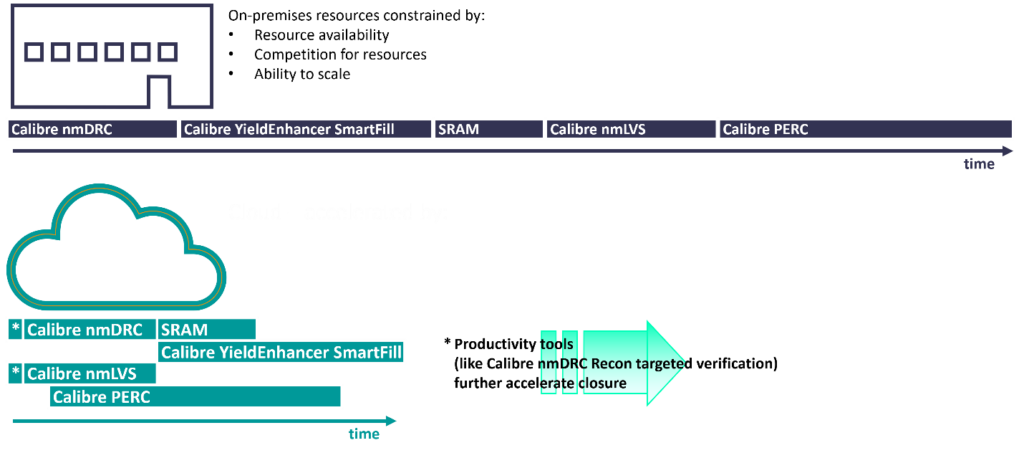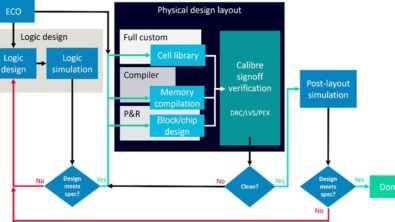Cloud Flight Plans enable cost-effective use of the cloud for peak productivity

By Chris Clee
You might ask, “What on Earth is a Cloud Flight Plan?” It’s a collection of best practices (or “best known methods,” BKMs) for running a specific tool flow (“workload”) in the cloud. It starts with selecting the right number and type of virtual machines and encompasses how your workloads should be set up for submission to cloud resources. It covers correct configuration of the Linux environment, filesystem choice, networking, how to leverage low-cost “spot” resources and all other aspects of setting up and running specific EDA tasks to get the best return on your spend in the cloud.
Download our newest technical paper that describes BKMs for Amazon Web Services (AWS), using Annapurna Labs’ experience as a benchmark. Running Calibre solutions in the cloud: Best known methods.
Flexibility, availability, scalability
Cloud compute offers capacity, scalability and high availability of virtual machines specifically tuned for EDA workloads. I am working with several of our Calibre customers because the cloud is an attractive path for semiconductor designers to address the burgeoning needs of their EDA workloads. I expect cloud compute to become the dominant model for high-performance compute (or HPC) over the next several years, in much the same way that the consolidation of core competencies and the economy of scale offered by the foundry model largely displaced the integrated device manufacture (or IDM) model over the last several decades.
Some of our customers are already fully embracing the cloud for all their EDA workflows. Others have roadmaps to transition over the next couple of years. But we recognize that many of our customers will maintain some kind of on-premises capability and migrate key workloads to the cloud, or they will use the cloud for peak demand. Figure 1 illustrates the difference between on-premises serial runs of Calibre tools vs. cloud runs.

All of this can be a bit scary, especially because the cost of everything you do in the cloud is very visible and easily traceable back to you as an individual. And although yes theoretically you can run any product in the cloud that you can run on-prem, that doesn’t mean that it will run well out of the box.
Also, there’s a bewildering amount of choice in the cloud: dozens of different classes of virtual machines, with only a fraction of these suitable for EDA workloads. There are also choices for networking, storage, security, queue management and so on. Each of these things needs to be selected and integrated carefully, taking into consideration the type of workload that the cloud infrastructure needs to support.
More throughput, less anxiety – introducing Cloud Flight Plans
So of course, our customers are asking us for help to select the right type of machine and the best configuration in the cloud for each workload. And this is exactly where we can help. We have been collaborating with the major cloud providers to construct Cloud Flight Plans for our customers. Cloud Flight Plans encapsulate a set of best-known methods so our customers can be clear about exactly how their cloud compute environments should be configured so that they get the best possible experience in the cloud, and that their EDA workloads, including Calibre nmDRC used for IC design physical verification, are performing at their peak potential.
When we think about our strategy for flight plans, we must be mindful of different customers having different strategies for cloud adoption. Some of our customers have an entirely on-premises compute environment. Some of our smaller customers want to run entirely in the cloud, and potentially opt for a Siemens-managed cloud environment where we provide something that’s completely turnkey. But in many cases, what we find that a hybrid model, where the customers are moving to the cloud for peak demand and additional capacity, is a very attractive proposition. This can be for a number of different reasons – overlapping projects, or it could be driven by the need to accelerate a tape out by adding capacity, for example.
Broad tactics, single goal
Our Cloud Flight Plans also encompass “infrastructure as code,” which is software that we can provide to help set up resource queues and other infrastructure inside your cloud environment. For example, our Cloud Reference Environment is a set of pre-packaged scripts that, with a few button clicks, can deploy an entire parallel compute cluster into the cloud. It establishes scalable SLURM queues based on virtual machines which, based on our own extensive testing, are optimal for running the major design flows offered by Siemens EDA.
Our Cloud Flight Plans include application notes and technical papers, as well as an infrastructure-as-code reference environment that creates an optimized scalable parallel cluster for running Siemens EDA design and verification flows. All of this, including the Cloud Reference Environment and other flow-specific assets and resources, is available to our customers now through our online SupportCenter resource, and through our global technical support organization. We also have a good number of other resources, including pieces that we developed jointly with our cloud provider partners.
Even more resources are available through our Cloud solutions web pages. Our newest technical paper available for download is Running Calibre solutions in the cloud: Best known methods.
Cloud Flight Plans: your guide to realize the full potential of the cloud
In the dynamic world of semiconductor design, cloud compute emerges as a cost-effective solution, with the strong caveat that resources and infrastructure must be optimized to suit the individual needs of each segment of the design flow. Cloud Flight Plans from Siemens EDA guide our customers through the cloud maze, ensuring optimal configurations. Whether fully embracing the cloud or adopting a hybrid model, our mission is clear: leverage the availability, scalability and flexibility of the cloud and boost designers to peak productivity.


